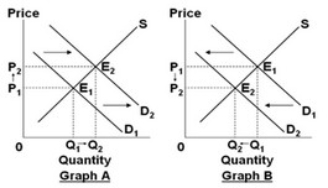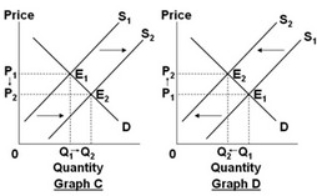A) consumer preferences are allowed to vary.
B) the prices of other goods are assumed constant.
C) money incomes are allowed to vary.
D) the supply curve of product X is assumed constant.
F) B) and C)
Correct Answer

verified
Correct Answer
verified
True/False
If demand increases and supply simultaneously decreases, equilibrium price will rise.
B) False
Correct Answer

verified
Correct Answer
verified
Multiple Choice
Assume that the demand curve for product C is downsloping. If the price of C falls from $2.00 to $1.75,
A) a smaller quantity of C will be demanded.
B) a larger quantity of C will be demanded.
C) the demand for C will increase.
D) the demand for C will decrease.
F) C) and D)
Correct Answer

verified
Correct Answer
verified
Multiple Choice
A decrease in the demand for recreational fishing boats might be caused by an increase in the
A) income of sports fishers.
B) price of outboard motors.
C) size and number of fish available.
D) price of sailing boats.
F) B) and D)
Correct Answer

verified
Correct Answer
verified
Multiple Choice
Since their introduction, prices of Blu-ray players have fallen and the quantity purchased has increased. This statement
A) suggests that the supply of Blu-ray players has increased.
B) suggests that the demand for Blu-ray players has increased.
C) constitutes an exception to the law of demand in that they suggest an upward-sloping demand curve.
D) constitutes an exception to the law of supply in that they suggest a downward-sloping supply curve.
F) A) and D)
Correct Answer

verified
Correct Answer
verified
Multiple Choice
If product Y is an inferior good, a decrease in consumer incomes will
A) make buyers want to buy less of Product Y.
B) not affect the sales of product Y.
C) shift the demand curve for product Y to the left.
D) shift the demand curve for product Y to the right.
F) B) and D)
Correct Answer

verified
Correct Answer
verified
Multiple Choice
Assume that the graphs show a competitive market for the product stated in the question. 
 Select the graph above that best shows the change in the market specified in the following situation: the market for digital cameras, when the productivity of workers in the digital camera industry increases.
Select the graph above that best shows the change in the market specified in the following situation: the market for digital cameras, when the productivity of workers in the digital camera industry increases.
A) Graph A
B) Graph B
C) Graph C
D) Graph D
F) A) and C)
Correct Answer

verified
Correct Answer
verified
Multiple Choice
Assume the demand curve for product X shifts to the right. This might be caused by
A) a decline in income if X is an inferior good.
B) a decline in the price of Z if X and Z are substitute goods.
C) a change in consumer tastes that is unfavorable to X.
D) an increase in the price of Y if X and Y are complementary goods.
F) All of the above
Correct Answer

verified
Correct Answer
verified
Multiple Choice
All of the following are assumed to be constant when the supply curve for a product is drawn, except the
A) price of the product.
B) production technology used by the firm.
C) number of producers.
D) price of inputs used to make the product.
F) B) and C)
Correct Answer

verified
Correct Answer
verified
True/False
A price floor in a competitive market will result in persistent shortages of a product.
B) False
Correct Answer

verified
Correct Answer
verified
True/False
In the foreign exchange market, if Canadian companies import more products from the U.S., then the demand for Canadian dollars will increase.
B) False
Correct Answer

verified
Correct Answer
verified
Multiple Choice
When central planners in a command economy end up having a huge surplus of shoes and widespread shortages of bread in their economy, they have failed to attain
A) productive efficiency.
B) allocative efficiency.
C) minimum opportunity costs.
D) maximum process and revenues.
F) B) and C)
Correct Answer

verified
Correct Answer
verified
Multiple Choice
If the price of a product decreases, we would expect
A) demand to increase.
B) quantity supplied to decrease.
C) supply to decrease.
D) quantity supplied to increase.
F) B) and D)
Correct Answer

verified
Correct Answer
verified
Multiple Choice
If the demand curve for product B shifts to the right as the price of product A declines, then
A) both A and B are inferior goods.
B) A is a superior good and B is an inferior good.
C) A is an inferior good and B is a superior good.
D) A and B are complementary goods.
F) B) and D)
Correct Answer

verified
Correct Answer
verified
Multiple Choice
In markets where the supply curve is vertical, changes in
A) demand will not cause the equilibrium price to change.
B) supply will not cause the equilibrium price to change.
C) demand will not cause the equilibrium quantity to change.
D) supply will not cause the equilibrium quantity to change.
F) A) and D)
Correct Answer

verified
Correct Answer
verified
Multiple Choice
All of the following would affect the position of the supply curve for cranberries, except the
A) popularity of cranberry drinks.
B) price of agricultural land for cranberries.
C) cost of fertilizers for cranberry production.
D) development of a new pest control for cranberries.
F) A) and D)
Correct Answer

verified
Correct Answer
verified
Multiple Choice
A government subsidy to the producers of a product
A) reduces product supply.
B) increases product supply.
C) reduces product demand.
D) increases product demand.
F) A) and C)
Correct Answer

verified
Correct Answer
verified
Multiple Choice
A government-set price floor on a product
A) does not interfere with the rationing function of price in a market system.
B) will drive resources away from the production of the product.
C) will attract more resources toward the production of the product.
D) is intended to benefit the buyers of the product.
F) A) and C)
Correct Answer

verified
Correct Answer
verified
Multiple Choice
Assuming competitive markets with typical supply and demand curves, which of the following statements is correct?
A) An increase in supply with a decrease in demand will result in an increase in price.
B) An increase in supply with no change in demand will result in an increase in price.
C) An increase in supply with no change in demand will result in a decline in sales.
D) An increase in demand with no change in supply will result in an increase in sales.
F) A) and D)
Correct Answer

verified
Correct Answer
verified
Multiple Choice
Allocative efficiency is concerned with
A) producing the combination of goods most desired by society.
B) achieving the full employment of all available resources.
C) producing every good with the least-cost combination of inputs.
D) reducing the concavity of the production possibilities curve.
F) All of the above
Correct Answer

verified
Correct Answer
verified
Showing 61 - 80 of 339
Related Exams